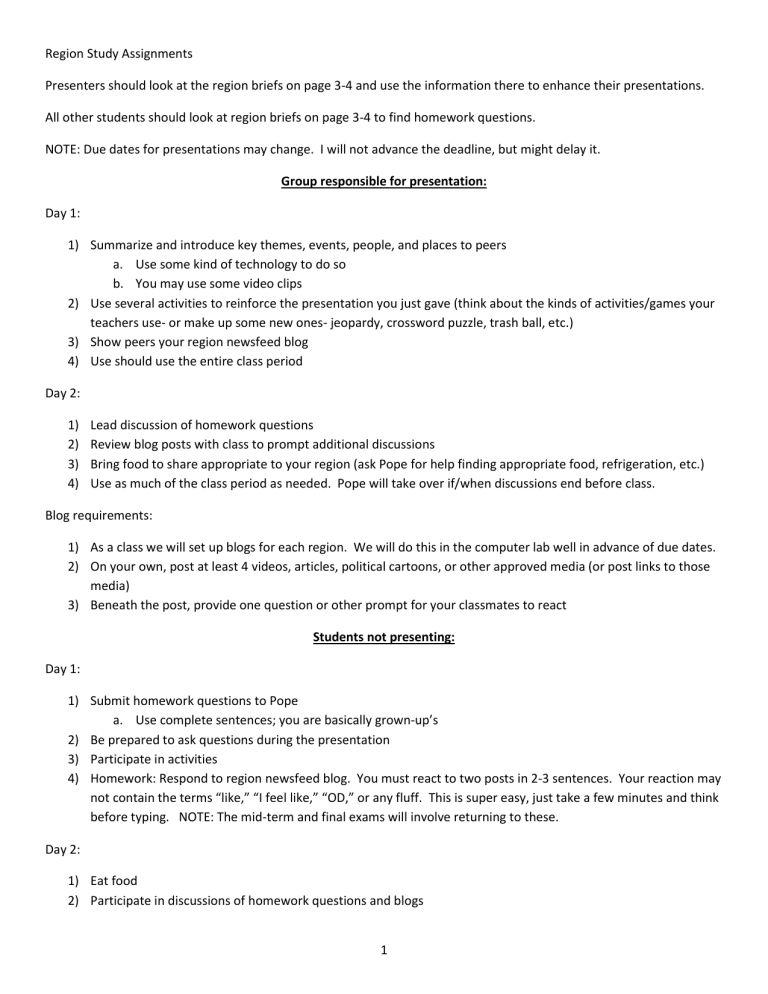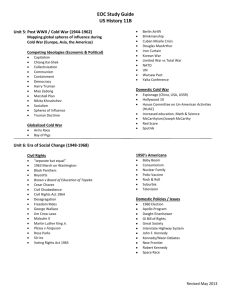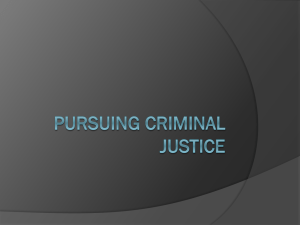Region Study Assignments Presenters should look at the region

Region Study Assignments
Presenters should look at the region briefs on page 3-4 and use the information there to enhance their presentations.
All other students should look at region briefs on page 3-4 to find homework questions.
NOTE: Due dates for presentations may change. I will not advance the deadline, but might delay it.
Group responsible for presentation:
Day 1:
1) Summarize and introduce key themes, events, people, and places to peers a.
Use some kind of technology to do so b.
You may use some video clips
2) Use several activities to reinforce the presentation you just gave (think about the kinds of activities/games your teachers use- or make up some new ones- jeopardy, crossword puzzle, trash ball, etc.)
3) Show peers your region newsfeed blog
4) Use should use the entire class period
Day 2:
1) Lead discussion of homework questions
2) Review blog posts with class to prompt additional discussions
3) Bring food to share appropriate to your region (ask Pope for help finding appropriate food, refrigeration, etc.)
4) Use as much of the class period as needed. Pope will take over if/when discussions end before class.
Blog requirements:
1) As a class we will set up blogs for each region. We will do this in the computer lab well in advance of due dates.
2) On your own, post at least 4 videos, articles, political cartoons, or other approved media (or post links to those media)
3) Beneath the post, provide one question or other prompt for your classmates to react
Students not presenting:
Day 1:
1) Submit homework questions to Pope a.
Use complete sentences; you are basically grown-up’s
2) Be prepared to ask questions during the presentation
3) Participate in activities
4) Homework: Respond to region newsfeed blog. You must react to two posts in 2-3 sentences. Your reaction may not contain the terms “like,” “I feel like,” “OD,” or any fluff. This is super easy, just take a few minutes and think before typing. NOTE: The mid-term and final exams will involve returning to these.
Day 2:
1) Eat food
2) Participate in discussions of homework questions and blogs
1
Region Study Rubric
Criteria
Summary/
Introduction
Presentation
Reinforcing
Activities
Blog
1
Does not summarize readings. Does not use examples, or does so ineffectively. Spelling and grammar errors.
Difficult to understand.
Do not include reinforcing activities or activities are not appropriate to unit.
Group does not complete blog.
2
Summarized main points but with little elaboration.
Spelling and grammar errors. Sometimes difficult to understand.
Use reinforcement, but does not run smoothly or does not take up entire class period. Activities include inaccuracies.
Group posts to blog, but does not meet requirements on page 1
Student evidences some work, but not as much as other group members.
3
Summarizes main ideas of readings. Uses examples.
Organized with an introduction, body, and conclusion. Few grammar and spelling errors.
Reinforcement activities are accurate and appropriate.
Use entire class period effectively.
4
Clearly and concisely summarizes main ideas of readings. Uses examples and quantitative data. Well organized and easily understood.
Reinforcement accurate and appropriate. Class is engaged and forced to think critically.
Group posts to blog and meets requirements. Weak prompts.
All students in group seem to share equal workload.
Posts to blog and meets requirements. Strong
Prompts.
Students “synergize” by working off each other to produce superior work.
Equal Share of
Work
Level of
Understanding
(“Expertness”)
Discussion
Questions
(2 nd Day)
Student does not evidence fair workload; does not appear that student is as prepared as group members.
Did not demonstrate knowledge of regional trends, people, events, and places. Used many inaccuracies.
Unable or unprepared to lead discussion of blog and/or homework questions.
Demonstrated some knowledge of trends, people, events, and places. Few inaccuracies.
Lead discussion but without prompting peers with follow-up questions.
Do not moderate class discussion.
Demonstrated knowledge of trends, events, people, and places. No inaccuracies.
Moderates and leads discussion well; asks followup questions or asks for clarification during discussion.
Demonstrated mastery of regional trends, events, people, and places.
Added to knowledge of class by integrating outside and updated news sources.
Moderates and leads discussion well; asks follow-up questions or for clarification during discussion. Class engaged during discussion with participation from variety of classmates.
Subtotal _____/24 x 4=________
Food? + 4
Total:_______
Comments:
2
Chapter 2: Rise of New Europe
Themes:
Economic Crisis in Russia, Corruption in Eastern Europe, Putin centralizing power, Resurgent Russian imperialism?, NATO expansion, Ethnic conflict, Conflict in former Yugoslavia, Economic Integration in Western Europe, Immigration from developing world, sluggish population growth, conflict in Northern Ireland
Key ideas:
Privatization, Stalinist demographic legacy (e.g. Nagorno-Karabakh & Nakhichevan), guerillas, ethnic conflict,
“balkanization,” shock therapy, Eurozone, eurosceptics, “Special Relationship,” paramilitary organizations
Key events: civil war in Chechnya, Russian invasion of Georgia, Velvet Revolution, civil war/breakup of Yugoslavia, German reunification, Good Friday Agreement
Key people/organizations:
Boris Yeltsin, Vladimir Putin, Gazprom, NATO, Commonwealth of Independent States (CIS), Marshall Tito, Slobodan
Milosevic, Helmut Kohl, Angela Merkel, “gastarbeiter” (guestworkers), Margaret Thatcher, Tony Blair, David Cameron,
IRA, Sinn Fein
Key places:
Russia, Moscow, Chechnya, Georgia, South Ossetia, Abkhazia, Caucasus Region, Kazakhstan, Armenia, Georgia,
Nakhichevan, Nagorno-Karabakh, Czech Republic and Slovakia, Yugoslavia, Bosnia-Herzegovina, Croatia, Slovenia,
Kosovo, Sarajevo, Belgrade, Germany, Berlin, France, Paris, Great Britain, Northern Ireland
Homework Questions:
Pg 13- #1-2; page 20-◊, pg 24- #2, pg 25- #2, pg 30- ◊, pg 40- #1-2, pg 40-42 parts A & C
3
Chapter 3: Africa in Crisis; skip Northern Africa section (skip 54- 56 & 63-67)
Themes:
Decolonization, civil war, economic growth, natural resource exploitation, colonial legacies, tribal rivalry, natural resource “curse”
Key ideas:
“kleptocracy,” apartheid, AIDS, military coup (coup d’etat), failed state, HIV/AIDS epidemic
Key events:
End of apartheid, Sudanese civil war, Darfur genocide, Somali civil wars, Somali piracy
Key people/organizations:
Zulus, Afrikaners, ANC, Nelson Mandela, Al Shabab, African Union (AU), Robert Mugabe
Key places:
South Africa, Kenya, Chad, Sudan, South Sudan, Darfur, Somalia, Mogadishu, Zimbabwe (Rhodesia)
Homework Questions: pg 50- #1, pg 54- #1 & 2, pg 61- #1-5 (make #4 a paragraph); pg 63- #1-2; pg 68- part B, D, and E
4
Chapter 4: Revolution in the Middle East & Portion from Africa in Crisis (54- 56 & 63-67)
Themes:
Arab Spring, sectarian violence, moderate v. extremist/violent Islamic fundamentalism, fundamentalism v. secularism,
Iran’s support of terrorist organizations, Iran’s nuclear weapon ambition, Arab-Israeli conflict, Shi’a-Sunni conflict, oil politics
Key ideas:
Islamic fundamentalism, caliphate, shari’a, pan-Arab nationalism, security zone (buffer zone), oil embargo, Wahhabism,
Israeli settlements, WMD’s (Weapons of Mass Destruction), “Surge”
Key events:
Lockerbie bombing (Pan Am flight 103), Arab Spring, Overthrow of Qaddafi, Jasmine Revolution, 1979 (big year-
Afghanistan, Mecca, Iran), Lebanese Civil War, Iran-Iraq War, Green Movement, Israeli war of Independence (1948),
Suez Crisis, Six-Day War, Yom Kippur War, intifada, Operation Desert Storm (Iraq Round 1; 1991), Iraq War (Round 2;
2003-2012), US withdraw from Iraq
Key people/organizations:
Muammar al Qaddafi, Ben Ali, King Muhammad VI, Taliban, al-Qaeda, Osama bin Laden, Hamid Karzai, Hosni Mubarak,
Muslim Brotherhood, Baath Party, Bashar al-Assad, Alawites, Palestine Liberation Organization, Hezbollah, Mahmoud
Ahmadinejad, Shah of Iran (Mohammed Reza Pahlavi), Ayatollah Khamenei, OPEC, King Abdullah II, Kurds, Palestinians
(Palestinian Arabs), Likud Party, Israeli Labor Party, Jewish settlements, Yasser Arafat, Yitzhak Rabin, Hamas, Benjamin
Netanyahu, Mahmoud Abbas, Fatah, Palestinian Authority, Saddam Hussein, David Petraeus
Key places:
Libya, Tunisia, Morocco, Afghanistan, Pakistan, Egypt, Syria, Lebanon, Beirut, Damascus, Iran, Tehran, Dubai, United
Arab Emirates, Kuwait, Yemen, Jordan, Israel, Gaza Strip, West Bank, Golan Heights, Sinai Peninsula, Suez Canal, Iraq,
Baghdad, Saudi Arabia, Persian Gulf, Strait of Hormuz, Mediterranean Sea, Gulf of Aqaba,
Homework Questions: pg 56- #1-2, pg 65- #2-3, pg 67-#1-2, pg 73- #1-3, pg 75-#2, pg 77- both ◊, pg 83- #2-3,pg 85- #1-3, pg 88- ◊, pg 90-#1, pg
95- #1-2, pg 100-101 Part C
Note to presenting group: we will spend several days on Arab-Israeli conflict, so you can go easy on that portion.
5
Chapter 10: Terrorism threatens Int’l Security
Themes:
War on Terror, Nationalist terrorist organizations, targeting the United States, global jihadist movement, “terrorist” v.
“freedom fighter,”
Key ideas: terrorism, separatists, international terrorism, state-sponsored terrorism, suicide attacks, goals of terrorism, rally around the flag effect, “Patriot Act,” WMD’s, nation-building (Don’t tell Bush I said so), Palestinian statehood, mujahedeen, US support of mujahedeen during Soviet-Afghan War, Northwest (“Frontier,” “Border,” “Tribal”) Pakistan as support base for extremism, jihad, “apostate regimes,” US drone strikes
Key events:
9/11, Capture/execution of Osama bin-Laden, 1983 Marine Barracks Beirut bombing, Lockerbie bombing (Pan Am Flight
103), US Embassy hostage crisis in Iran (444 Days), 1993 World Trade Center bombing, Oklahoma City Federal Building bombing, Kenya & Tanzania US embassy bombing, USS Cole attack, US invasion of Afghanistan, US invasion of Iraq
(2003), 1972 Munich Olympic Games Attack, Entebbe airport hijacking, 1982 Israeli invasion of Lebanon, intifada, Soviet invasion of Afghanistan
Key people/organizations:
Irgun, Stern Group, ETA, Shining Path (Sendero Luminoso), Al-Qaeda, Osama bin-Laden, Red Army Faction, Anwar el-
Sadat, Indira Gandhi, LTTE (Tamil Tigers-Sri Lanka), Department of Homeland Security, President Pervez Musharraf,
Saddam Hussein, PLO, Yasser Arafat, Fatah, Black September, Mossad, Mahmoud Abbas, Hamas, Palestinian Authority,
Ayman al-Zawahri
Key places:
Afghanistan, Pakistan, Egypt, Syria, Lebanon, Beirut, Iran, Yemen, Israel, Gaza Strip, West Bank, Jordan, Iraq, Baghdad,
Saudi Arabia, Mecca, Medina, Jerusalem
Homework Questions:
Pg 235- ◊, pg 236- ◊, 238- ◊, 240- ◊, pg 241- #1-2, 242- ◊, pg 243- #1-3, pg 246- #1-3, pg 248-◊, pg 251- #1-3, pg 252, Part
C, Question 1 & 3, pg 254- Part E, Question 1
6
Chapter 5: Political and Economic Turmoil in Asia
Themes:
Modernization of China, Chinese and Indian population growth, Human rights abuses in China, Japanese growth and shrinkage, US force posture in East Asia, North Korea: Hermit Kingdom, Asian Tigers, Religious tension in India,
Key ideas:
Communism, Maoism, Special Economic Zones (SEZ’s), privatization, state-owned enterprises (SOE’s) , blue water navy, rare earth metals, zaibatsu, nuclear umbrella, tsunami, six-party talks with North Korea, chaebol
Key events:
Tiananmen Square Massacre, Opium Wars, Korean War, World War II, Vietnam War, Cambodian Civil War,
Key people/organizations:
Chinese Communist Party, Mao Zedong, Kuomintang (Goumindong), Chiang Kai-shek, Deng Xiaoping, Kim Il Sung, Kim
Jong Il, Kim Jong Un, Khmer Rouge, Pol Pot, ISI (Inter Services Intelligence- Pakistan Intelligence Service), Sikhs, Indira
Gandhi, Mahatma Gandhi, BJP, Benazir Bhutto, Pervez Musharraf, Asif Ali Zardari, Afghan Taliban, Pakistani Taliban
(Pushtun & Punjabi), Haqqani network,
Key places:
China, Tibet, Taiwan, Beijing, Taipei, North Korea, South Korea, Pyongyang, Seoul, Hong Kong, South China Sea, Strait of
Malacca, Okinawa, Cambodia, Vietnam, Hanoi, Ho Chi Minh City (Saigon), India, New Dehli, Kashmir, Pakistan,
Afghanistan, Islamabad, Bangladesh, Swat Valley, Waziristan,
Homework Questions:
Pg 106- ◊, pg 108- #1-2, pg 109-110- #1 & 3, pg 113- ◊, pg 118- 1, 2, & 4, pg 120- 1 & 2, pg 125- #2, pg 127- #1, pg 128-
129- Part C
7
Chapter 6: Drugs and Politics in Latin America
Themes:
Fear of American imperialism, Drug War, Venezuela’s (Chavez’s) influence, oil politics, political corruption, military involvement in the political process
Key ideas:
Traficantes, Narcoterrorism, “War system” (Columbia), NAFTA, immigration, junta, nationalization (as in nationalized industries), nepotism, populism, cronyism/clientalism (spoils system), US trade embargo with Cuba, remittances
Key events:
Colombian civil war, Election of Vincente Fox (End of PRI Party dominance), Election of Hugo Chavez, Cuban Revolution,
Bay of Pigs “invasion,” Cuban Missile Crisis
Key people/organizations:
DEA, FARC, ELN, Vincente Fox, Felipe Calderon, Evo Morales, Hugo Chavez, Shining Path (Sendero Luminoso), Lula da
Silva, IMF (International Monetary Fund), Dilma Rousseff, Juan (and Eva) Peron, Nestor and Cristina Kirchner, Fidel
Castro, Organization of American States, Raul Castro
Key places:
Colombia, Mexico, Ciudad Juarez, Mexico City, Bolivia, Peru, Venezuela, Brazil, Argentina, Cuba
Homework Questions:
Pg 135- ◊, pg 136- #2, pg 143- #1 & 2, pg 145- #1-3, pg 148- #1, pg 153- ◊, pg 155- Part C
8



